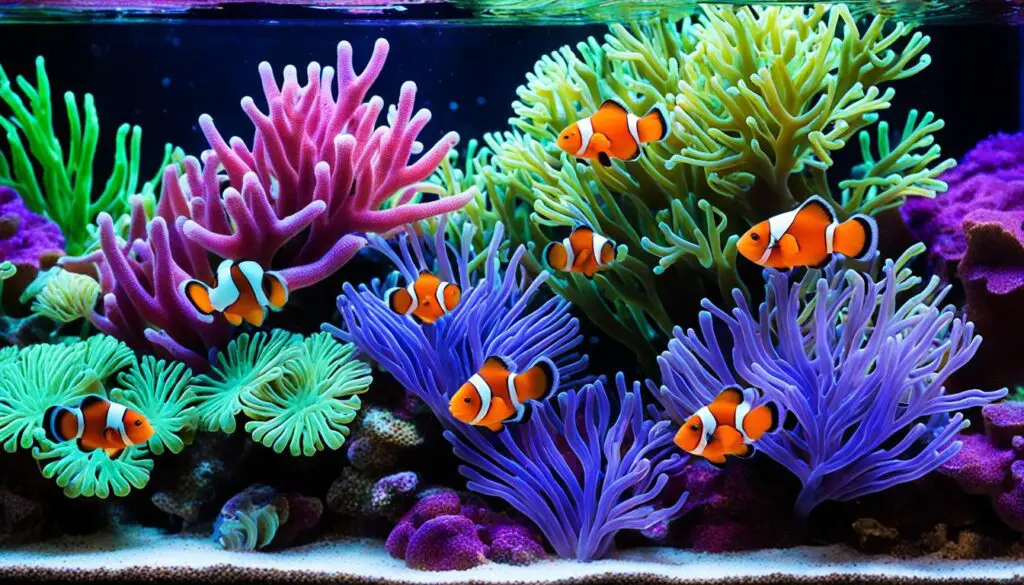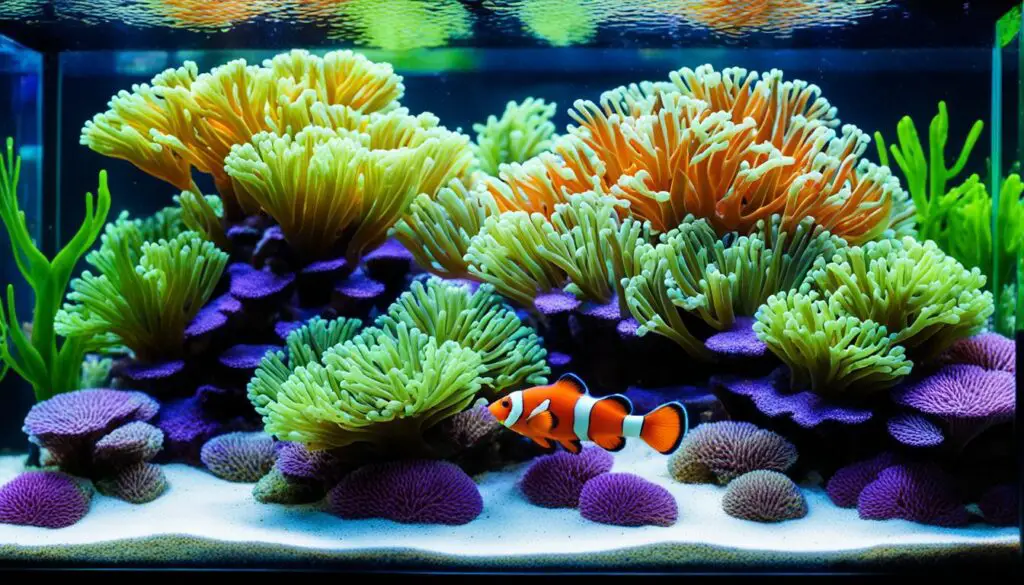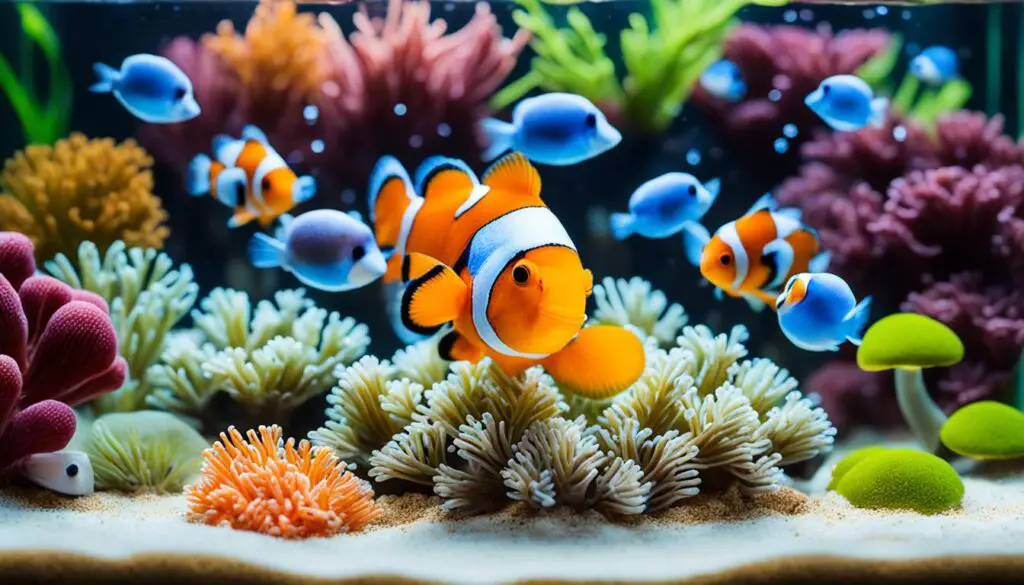Keeping Your Clownfish Tank Clean: Essential Maintenance Tips
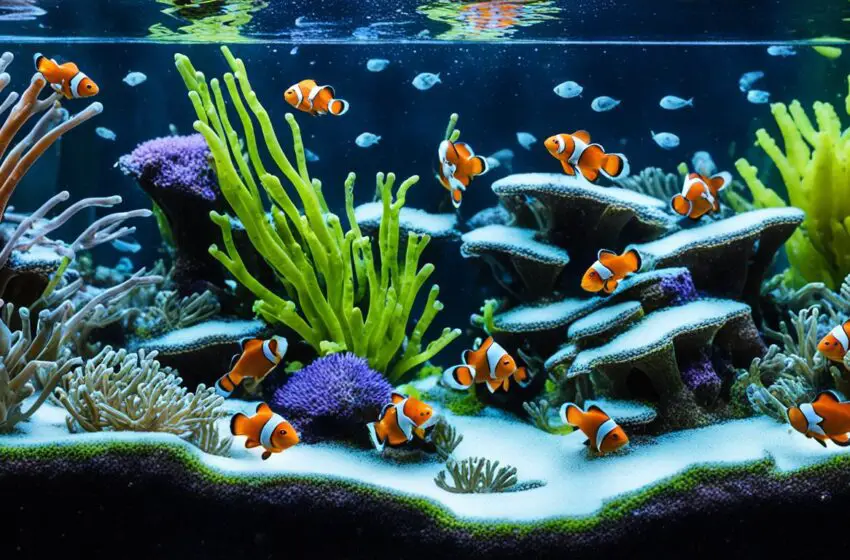
Clownfish are loved by many for their bright colors and fun habits. If you own clownfish, taking good care of them is key. This guide will give you tips for a clean and happy tank. It’s all based on trusted advice, so you can rely on what you’re learning.
Key Takeaways:
- Regular maintenance is vital for the well-being of your clownfish and for creating a stress-free environment in their tank.
- Performing regular water changes and monitoring water quality parameters are essential maintenance tasks.
- Cleaning the tank and its accessories will prevent the buildup of waste and ensure a clean and healthy environment.
- Providing a suitable diet and monitoring clownfish behavior are crucial for maintaining their overall health and happiness.
- Researching and understanding the specific needs of your clownfish species will help you create an ideal habitat.
Understanding Clownfish Species and Tank Requirements
Clownfish, or anemonefish, are amazing saltwater fish in various species. Each type has its unique traits and needs. So, it’s crucial to pick the right one for your tank.
Picking a clownfish species means thinking about their friends in the tank. Some get along well with certain fish. But others might pick fights or need their space. Doing your homework and asking experts will guide you to a friendly fish mix.
Clownfish require certain things in a tank to be happy. They need a home that’s at least 29 gallons. Bigger tanks are even better for them. Water should be between 74-80 degrees Fahrenheit, and very salty.
Having the right filter and checking the water often is key for clownfish happiness. A good filter takes out dirt and keeps water clean. Test the water for things like pH, too. This ensures the fish live in a healthy place.
Common Clownfish Species
There are several kinds of clownfish that people like to keep:
- Percula Clownfish (Amphiprion percula)
- Ocellaris Clownfish (Amphiprion ocellaris)
- Tomato Clownfish (Amphiprion frenatus)
- Maroon Clownfish (Premnas biaculeatus)
Each type has its own looks and behavior. You can pick the one that captures your heart. Remember, some need special care. Make sure you’re ready for that before getting one.
Tank Setup for Clownfish
In the wild, clownfish live near anemones. But, they can do well without them at home. Still, it’s great to have hiding spots like rocks or corals. These make them feel safe and happy.
Tip: Avoid placing sharp or aggressive corals in the tank, as clownfish may get injured. Stick to soft or peaceful corals instead.
Adding new friends to the tank with your clownfish needs thought. Some fish get along with clownfish, like angelfish or gobies. But choose wisely to keep the peace.
To wrap it up, knowing the different types of clownfish and what they need is key. By choosing the right kind, setting up a proper tank, and picking fish friends carefully, you’ll have a beautiful clownfish home.
Creating a Suitable Clownfish Habitat
To keep clownfish happy in your aquarium, their home must be right. This means picking the right friends for them and having a good cleaning system. This makes them feel like they’re in their natural home and keeps them healthy.
1. Hiding Places
Clownfish love hiding and feeling safe. Fill the tank with places to hide like rocks and plants. These spots don’t just make them feel secure; they also look nice in your tank.
2. Suitable Tankmates
It’s key to choose the right friends for your clownfish. Some fish fit well, while others can be mean. Pick tankmates like angelfish and blennies that get along. This makes a happy home for all in your aquarium.
3. Proper Filtration System
Clean water is vital for your clownfish’s health. A good filter helps keep the water clean and clear. Use a filter that is right for your tank’s size and think about adding a protein skimmer. This extra tool can really help clean the water well.
To make your tank a perfect place for clownfish, set up hiding spots, choose the right friends, and keep the water clean. Keep an eye on the water and always feed them well. Following these tips will keep your clownfish healthy and happy in their home.
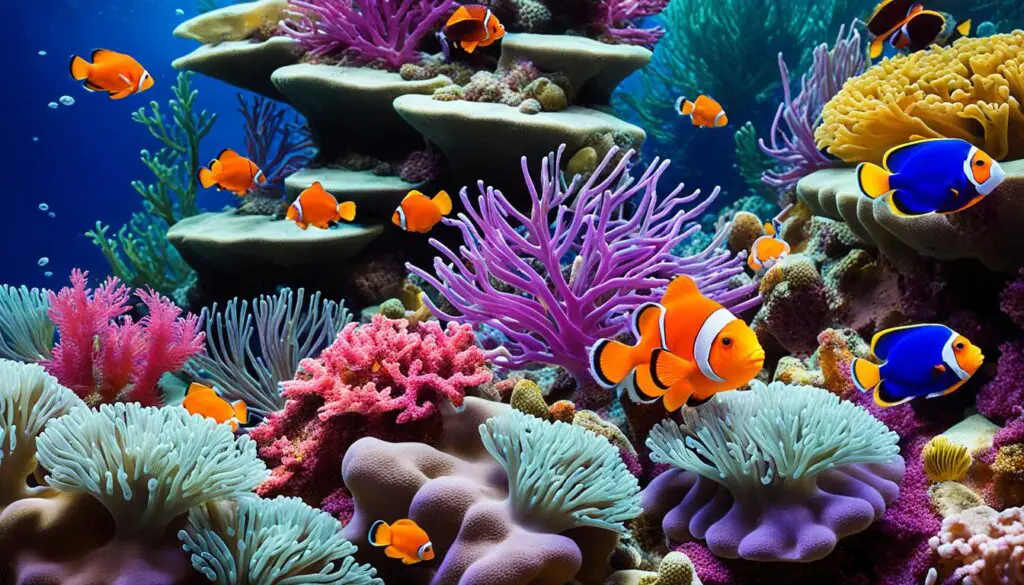
Essential Clownfish Tank Maintenance
Regular maintenance is key to a clean and stress-free clownfish tank. By keeping up with cleaning and changing the water, you help your fish stay healthy.
Changing the water regularly is very important. You should change 10-25% of the water every two to four weeks. This gets rid of debris and harmful things, making the water better for your clownfish.
Don’t forget to clean the tank and its decorations. Use a safe cleaner to get rid of algae. Always make sure to rinse things well to keep your fish safe.
It’s also crucial to check the water’s quality often. Test the temperature, salinity, and more regularly. This makes sure the water is just right for your fish to live well.
Feeding your clownfish right is another important step. Give them high-quality fish flakes regularly. You can also offer them algae or shrimp sometimes. This keeps your fish healthy and their colors bright.’
FAQ
What size tank do clownfish need?
Clownfish need at least a 29-gallon tank, which can vary by species.
What water temperature do clownfish prefer?
They like the water to be between 74 and 80 degrees Fahrenheit.
What specific gravity should the water be for clownfish?
The water’s specific gravity should be between 1.020 and 1.025 for clownfish.
What tankmates are suitable for clownfish?
Clownfish can live with select fish such as angelfish, gobies, and blennies. It’s important to check if they’re a good match to prevent fighting.
Why is a filtration system important for clownfish tanks?
Filtration keeps the water clean and free of harmful substances for clownfish.
How often should I perform water changes in my clownfish tank?
Change 10-25% of the water every two to four weeks to keep it fresh.
How should I clean my clownfish tank and accessories?
Clean the tank and its parts regularly to give the clownfish a tidy home and reduce their stress.
What should I feed my clownfish?
Feed them top-quality marine fish flakes. Every now and then, mix in some algae or shrimp for variety.

